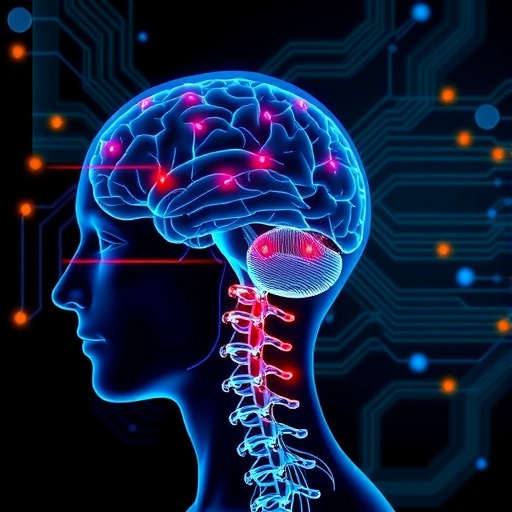
Scientists at Washington University in St. Louis have made significant strides in spinal cord injury research, an area that has long puzzled medical professionals and researchers alike. The core of the issue lies in the disruption of communication between the brain and spinal cord, which can lead to devastating outcomes such as paralysis. With the brain intact and functioning normally, the potential for recovery and rehabilitation remains viable if scientists can find a way to re-establish this critical communication pathway.
The innovative work led by Ismael Seáñez, assistant professor of biomedical engineering at the McKelvey School of Engineering, represents a blend of neuroscience and engineering aimed at restoring the lost communication. Seáñez and his team, including doctoral student Carolyn Atkinson, have developed an advanced type of decoder. This groundbreaking technology aims to harness brain activity to cue movement even in individuals with spinal cord injuries, thereby offering a new hope for rehabilitation.
Their research explores transcutaneous spinal cord stimulation, which utilizes noninvasive electrical stimulation to activate specific spinal circuits. The remarkable aspect of their study is that it involves a sample of 17 human subjects without spinal cord injuries, who participated in experiments that tested the feasibility of cueing lower leg movements only through thought processes. This pivotal phase of the research underscores the importance of understanding neural intentions—essentially what the brain wants the body to do, even if physical movement is not possible.
A specially designed cap equipped with noninvasive electrodes, which measure brain activity through electroencephalography (EEG), facilitated the critical data collection during experiments. Participants were seated and instructed to perform a leg extension at the knee and, in a subsequent scenario, instructed to merely think about extending their leg while it remained stationary. This dual-task approach aimed to reveal the patterns and strategies employed by the brain during actual movement compared to imagined movement.
By feeding this neural activity into their decoder algorithm, Seáñez and his team made a groundbreaking finding: the brain exhibited similar neural strategies in both situations. This discovery illustrates that the anticipated brain activity is not solely linked to actual movements. Instead, the researchers realized that they could predict when subjects were thinking about moving their legs even when there was no actual movement occurring. This revelation opens up exciting avenues for developing rehabilitation strategies for those living with spinal cord injuries.
In further enhancing the reliability of their findings, Seáñez emphasized the necessity of ensuring that participants were indeed imagining movement without physically moving their legs. The potential for signal noise to affect data integrity prompted the team to conduct extensive controls during the experiments. This approach ensured that the learning process focused exclusively on “movement intention” rather than extraneous signals which could distort the results.
The implications of this research are profound. The ability to decode movements purely from thought presents a substantial leap toward developing a noninvasive brain-spine interface. This interface could utilize real-time predictions to coordinate spinal cord stimulation, thereby reinforcing voluntary movement in patients undergoing rehabilitation after spinal cord injuries. The potential for significant improvements in patient outcomes could change the landscape of recovery and reintegration into everyday life for those affected.
Looking ahead, the team aims to expand their research horizon by investigating the possibility of a generalized decoder. This ambitious concept hinges on training a single decoder using data gathered from all participants instead of tailoring individual decoders for each specific user. By simplifying the process and making it universally applicable, the feasibility of implementing such advanced technology in clinical settings increases, thus promoting accessibility for a broader range of patients.
As this research garners attention, it bears the potential not only to enhance the scientific community’s understanding of brain and spinal cord communication but also to affect policy decisions and funding for similar studies. With further developments in brain-computer interface technologies, the rehabilitation landscape could see transformative impacts over the coming years.
Moreover, the significance of this research extends beyond the immediate clinical applications. As individuals regaining movement would regain independence and improve their quality of life, society at large benefits from improved healthcare outcomes and reduced long-term dependency on caregiving resources. This holistic change represents the type of breakthrough scientists and engineers aspire to achieve.
In summary, the collaborative research at Washington University highlights the intricate connections between neuroscience and engineering. With advancements in decoding brain activity and harnessing it for rehabilitation, the findings represent a promising frontier in treating spinal cord injuries. The ongoing efforts by Seáñez and his lab signal a hopeful future where individuals with paralysis can regain control of their bodies through the remarkable power of thought.
Subject of Research: Restoration of Communication in Spinal Cord Injuries Using Neural Decoding
Article Title: Enhancing Movement Recovery in Spinal Cord Injuries through Brain Decoding Technology
News Publication Date: April 25, 2025
Web References: Journal of NeuroEngineering and Rehabilitation
References: Atkinson C, Lombardi L, Lang M, Keesey R, Hawthorn R, Seitz Z, Leuthardt EC, Brunner P, Seáñez I. Development and evaluation of a non-invasive brain-spine interface using transcutaneous spinal cord stimulation. Journal of NeuroEngineering and Rehabilitation, online April 25, 2025. DOI: https://doi.org/10.1186/s12984-025-01628-6
Image Credits: Washington University in St. Louis
Keywords
Spinal cord injuries, Brain-computer interface, Neural decoding, Biomedical engineering, Rehabilitation.
Tags: advanced decoder developmentbrain-decoder technologycommunication between brain and spinal cordhuman subjects spinal cord experimentsinnovative spinal cord injury solutionsIsmael Seáñez biomedical engineeringMcKelvey School of Engineering researchneuroscience and engineeringnoninvasive electrical stimulationrehabilitation for spinal cord injuriesspinal cord stimulation researchtranscutaneous spinal cord stimulation





